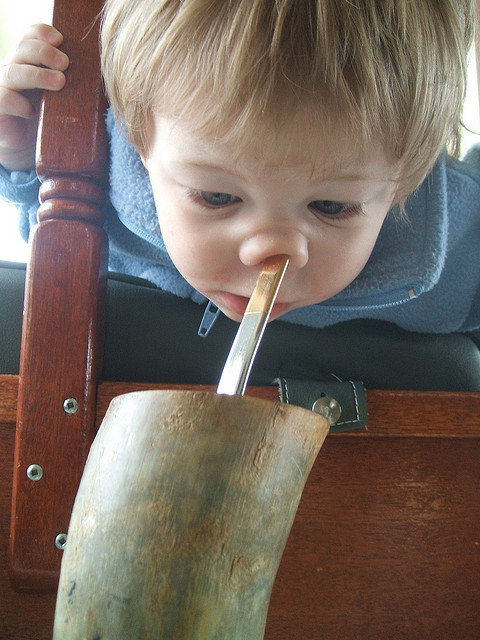Archive for September, 2015
The cards don’t matter. What matters is how you play them.
 What you think of yourself colors everything you do. When someone challenges your ideas, your response makes it clear how you see yourself. Regardless of your response, you tip your hand. Regardless of your response, everyone can see your cards.
What you think of yourself colors everything you do. When someone challenges your ideas, your response makes it clear how you see yourself. Regardless of your response, you tip your hand. Regardless of your response, everyone can see your cards.
When you have a terrible poker hand like, say, a king high, you can respond three ways. You can fold and let the challenger go unchallenged. You can check and kick the can down the road. Or you can bluff and go toe-to-toe with the challenger. With the fold you see things as they are and behave accordingly. The fold is an admission you have a lesser hand. And sometimes that’s difficult to do. The check says you don’t want others to know you have a terrible hand but you thing things will turn around. With the bluff you pretend things are different than they are and you pretend accordingly. You may fool the unseasoned player on your right, but make no mistake, the card shark on your left knows you’re bluffing. And deep down, you know too.
With a middle-of-the-road hand like the full house you have the same options. The fold is less likely because your hand is stronger. You fold only when you sense a strong challenge and the pot is large. No sense going head-to-head with a player with swagger when the stakes are high. There’s no harm in folding. The check says you’re not sure of yourself, or, you are and your hand is neither special nor terrible. The bluff is still risky but less so. If you think you can survive getting caught and are okay with the follow-on judgement, there’s a larger probability you’ll try.
With four aces you call the shots. The fold is reserved for those special situations where you want to preserve the status of players you care about. Or, when you have enough chips and you want others to get the glory. Either way it’s too little used. Few have the self-worth, generosity and thoughtfulness to play things that way. The check is equally generous. The check says you’re comfortable with your cards and how the hand is going. No need to flex your muscles. When you have the winning cards the bluff is counterproductive. Playing bigger than your hand pushes everyone away and they fold. You may with the pot, but next hand they’ll go after you. Embarrassing the other players is no way to play.
Really, though, your cards don’t matter. Regardless of your cards, don’t take a challenge personally. Regardless of your cards, respond like you hold all of them – all the aces, face cards, and all the wild cards.
It relatively easy to behave this way when the professional challenges your ideas because they don’t challenge you, they challenge your ideas. And you are not your ideas. Look deeply and honestly at the ideas and leave your self out of it. But it’s more difficult with the hack. Under the banner of challenging your ideas, the hack will try to challenge you. Here’s where you’ve got to hold onto a fundamental truth – no one can challenge you without your consent. Here’s where you’ve got to remember this truth applies to everyone – those with a four-of-a-kind, those with a full house, and those with a pair of twos. Here’s where you’ve got to remember that your cards don’t matter. The best way I know how to do that is to visualize your self as a screen door and let their hot air pass through you.
The challenges don’t matter and neither does the hand you were dealt. All that matters is your response. Respond with your heart’s best intentions and everyone will split the pot and they’ll want you to deal every hand.
Image credit – lawrence
The Chief Do-the-Right-Thing Officer – a new role to protect your brand.
 Our unhealthy fascination with ever-increasing shareholder value has officially gone too far. In some companies dishonesty is now more culturally acceptable than missing the numbers. (Unless, of course, you get caught. Then, it’s time for apologies.) The sacrosanct mission statement can’t save us. Even the most noble can be stomped dead by the dirty boots of profitability.
Our unhealthy fascination with ever-increasing shareholder value has officially gone too far. In some companies dishonesty is now more culturally acceptable than missing the numbers. (Unless, of course, you get caught. Then, it’s time for apologies.) The sacrosanct mission statement can’t save us. Even the most noble can be stomped dead by the dirty boots of profitability.
Though, legally, companies can self-regulate, practically, they cannot. There’s nothing to balance the one-sided, hedonistic pursuit of profitability. What’s needed is a counterbalancing mechanism of equal and opposite force. What’s needed is a new role that is missing from today’s org chart and does not have a name.
Ombudsman isn’t the right word, but part of it is right – the part that investigates. But the tense is wrong – the ombudsman has after-the-fact responsibility. The ombudsman gets to work after the bad deed is done. And another weakness – ombudsman don’t have equal-and-opposite power of the C-suite profitability monsters. But most important, and what can be built on, is the independent nature of the ombudsman.
Maybe it’s a proactive ombudsman with authority on par with the Board of Directors. And maybe their independence should be similar to a Supreme Court justice. But that’s not enough. This role requires hulk-like strength to smash through the organizational obfuscation fueled by incentive compensation and x-ray vision to see through the magical cloaking power of financial shenanigans. But there’s more. The role requires a deep understanding of complex adaptive systems (people systems), technology, patents and regulatory compliance; the nose of an experienced bloodhound to sniff out the foul; and the jaws of a pit bull that clamp down and don’t let go.
Ombudsman is more wrong than right. I think liability is better. Liability, as a word, has teeth. It sounds like it could jeopardize profitability, which gives it importance. And everyone knows liability is supposed to be avoided, so they’d expect the work to be proactive. And since liability can mean just about anything, it could provide the much needed latitude to follow the scent wherever it takes. Chief Liability Officer (CLO) has a nice ring to it.
[The Chief Do-The-Right-Thing Officer is probably the best name, but its acronym is too long.]
But the Chief Liability Officer (CLO) must be different than the Chief Innovation Officer (CIO), who has all the responsibility to do innovation with none of the authority to get it done. The CLO must have a gavel as loud as the Chief Justice’s, but the CLO does not wear the glasses of a lawyer. The CLO wears the saffron robes of morality and ethics.
Is Chief Liability Officer the right name? I don’t know. Does the CLO report to the CEO or the Board of Directors? Don’t know. How does the CLO become a natural part of how we do business? I don’t know that either.
But what I do know, it’s time to have those discussions.
Image credit – Dietmar Temps
Geometric Success Through Mentorship
 Business processes and operating plans don’t get things done. People do. And the true blocker of progress is not bureaucracy; it’s the lack of clarity of people. And that’s why mentorship is so important.
Business processes and operating plans don’t get things done. People do. And the true blocker of progress is not bureaucracy; it’s the lack of clarity of people. And that’s why mentorship is so important.
My definition of mentorship is: work that provides knowledge, support and advocacy necessary for new people to get things done. New can be new to company, new to role, or new to new environments or circumstances.
Mentorship is about helping new people recognize and understand unwritten rules on how things are done; helping them see the invisible power dynamics that generate the invisible forcing function that makes things happen; and supporting them as they navigate the organizational riptide.
The first job of a mentor is to commit to spending time with a worthy mentee. Check-the-box mentorship (mentorship for compliance) does not take a lot of time. (Usually several meetings will do.) But mentorship done well, mentorship worthy of the mentee, takes time and emotional investment.
Mentorship starts with a single page definition of the projects the mentee must get done. It’s a simple spreadsheet where each project has its own row with multiple columns for the projects that define: what must get done by the end of the year, and how to know it was done; the major milestones (and dates) along the way; what was done last month; what will be done this month. After all the projects are listed in order of importance, the number of projects is reduced from 10-20 down to 3-4. The idea is to list on the front of the page only the projects that can be accomplished by a mere mortal. The remaining 16-17 are moved to the back, never to be discussed again. (It’s still one page if you use the back.)
[Note: The mentee’s leader will be happy you helped reduce the workload down to a reasonable set of projects. They knew there were too many projects, but their boss wanted them to sign up for too much to ensure there was no chance of success and no time to think.]
Once the year-end definition of success is formalized for each project, this month’s tasks are defined. Using your knowledge of organizational dynamics and how things actually get done, you tell them what to do and how to do it. For the next four weekly meetings you ask them what they and help them get the tasks done. You don’t do the tasks for them, you tell them how to do it and how to work with. Over the next months, telling morphs to suggesting.
The learning comes when your suggested approach differs from their logical, straightforward approach. You explain the history, explain the official process is outdated and no one does it that way, suggest they talk to the little-known subject matter expert who has done similar work and introduce them to the deep-in-the-org-chart stalwart who can allocate resources to support the work.
Week-by-week and month-by-month, the project work gets done and the mentee learns how to get it done. The process continues for at least one year. If you are not willing to meet 40-50 times over the course of a year, you aren’t serious about mentorship. Think that’s too much? It isn’t. That’s what it takes. Still think that’s too much? If you meet for 30 minutes a week, that’s only 20-25 hours per year. At the end of a year, 3-4 projects will be completed successfully and a new person will know how to do 3-4 more next year, and the year after that. Then, because they know the value of mentorship, they become a mentor and help a new person get 3-4 projects done. That’s a lot of projects. Done right, success through mentorship is geometric.
Companies are successful when they complete their projects. And the knowledge needed to complete the projects is not captured in the flowcharts of the official business processes – it’s captured in the hearts and minds of the people.
New people don’t know how things get done, but they need to. And mentorship is the best way to teach them. It’s impossible to calculate the return on investment (ROI) for mentorship. You either believe in mentorship or you don’t. And I believe in it.
My mentorship work is my most meaningful work, and it has little to do with the remarkable business results. The personal relationships I have developed through my mentorship work are some of the most rewarding of my life.
I urge you, for your own well-being, to give mentorship a try.
Image credit — Bryan Jones
A most powerful practice – Try It.
 The first question is usually – What’s the best practice? And the second question is – Why aren’t you using it? In the done-it-before domain this makes sense. Best practices are best when inputs are tightly controlled, process steps are narrowly defined, and the desired output is known and can be formally defined.
The first question is usually – What’s the best practice? And the second question is – Why aren’t you using it? In the done-it-before domain this makes sense. Best practices are best when inputs are tightly controlled, process steps are narrowly defined, and the desired output is known and can be formally defined.
Industry loves best practice because they are so productive. Like the printing press, best practices are highly effective when it’s time to print the same pages over and over. It worked here, so do it there. And there. And there. Use the same typeface and crank it out – page by page. It’s like printing money.
Best practices are best utilized in the manufacturing domain, until they’re not. Which best practice should be used? Can it be used as-is, or must it change? And, if a best practice is changed, which version is best? Even in the tightly controlled domain of manufacturing, it’s tricky to effectively use best practices. (Maybe what’s needed is a best practice for using best practices.)
Best practices can be good when there’s strong commonality with previous work, but when the work is purposefully different (think creativity and innovation), all bets are off. But that doesn’t stop the powerful pull of productivity from jamming round best practices into square holes. In the domain of different, everything’s different – the line of customer goodness, the underpinning technology and the processes to make it, sell it, and service it. By definition, the shape of a best practice does not fit work that has yet to be done for the first time.
What’s needed is a flexible practice that can handle the variability, volatility, and uncertainty of creativity/innovation. My favorite is called – Try It. It’s a simple process (just one step), but it’s a good one. The hard part is deciding what to try. Here are some ways to decide.
No-to-yes. Define the range of inputs for the existing products and try something outside those limits.
Less-with-far-less. Reduce the performance (yes, less performance) of the very thing that makes your product successful and try adolescent technologies with a radically lower cost structures. When successful, sell to new customers.
Lines of customer goodness. Define the primary line of customer goodness of your most successful product and try things that advance different lines. When you succeed, change all your marketing documents and sales tools, reeducate your sales force, and sell the new value to new customers.
Compete with no one. Define a fundamental constraint that blocks all products in your industry, try new ideas that compromise everything sacred to free up novel design space and break the constraint. Then, sell new products into the new market you just created.
IBE (Innovation Burst Event). Everything starts with a business objective.
There is no best way to implement the Try It process, other than, of course, to try it.
Image credit — Alland Dharmawan.
Recalibrating Your Fear
 Everyone is looking for that new thing, that differentiator, that edge. The important filtering question is: Has it been done before? If it has been done before it cannot be a new thing (that’s a rule), so it’s important to limit yourself to things that have not been done. Sounds silly to say, but with today’s hectic pace sometimes that distinction is overlooked.
Everyone is looking for that new thing, that differentiator, that edge. The important filtering question is: Has it been done before? If it has been done before it cannot be a new thing (that’s a rule), so it’s important to limit yourself to things that have not been done. Sounds silly to say, but with today’s hectic pace sometimes that distinction is overlooked.
Once your eyeballs are calibrated, it pretty easy to see the vital yet-to-be-done work. But calibration is definitely needed because things don’t look as they seem. Here are a few examples to help you calibrate.
“It can’t be done.” This really means is it was tried some time ago by someone who doesn’t work here anymore and we’ve forgotten why, but the one experiment that was run did not work. This a good indication of fertile ground. Someone a long time ago thought it was important enough to try and it still has not been done successfully. And, new materials and manufacturing processes have been created and opened up new design space. Give it a try.
“That will never work.” See above.
“You can’t do that.” This means you (and, likely your industry) have a policy that has blocks this new idea. It may not be the best idea, but since policy prohibits it, you have the design space all to yourself if you want it. (That is, of course, if you want to compete with no one.) Likely there are no physical constraints, just the emotional constraints you created with your policy. It’s all yours, if you try it.
“No one will buy that.” This means no one offers a product like that. It means your industry doesn’t understand it because you or your competitors don’t sell anything like it. Though Marketing knows the inherent uncertainty, they don’t know the market potential. But you know you’re onto something. Try it.
“That’s just a niche market.” This means there’s a market that’s buying your product even though you’ve spent no time or energy to develop that market. It’s an accidental market. It’s small because it’s young and because you (and your competition) haven’t invested in it nor have developed an unique new product for it. The growth is all yours if you try.
Organizations create blocking mechanisms and tricky language to protect themselves from the new-and-different because the new-and-different are scary. But organizations desperately need new-and-different. And for that they desperately need to do things that haven’t been done.
The first step is to recognize the fertile design space and untilled markets your fear has created for you.
Image credit — Jordan Oram
 Mike Shipulski
Mike Shipulski